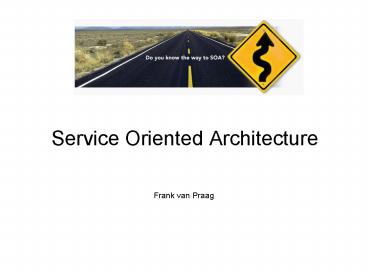Service Oriented Architecture - PowerPoint PPT Presentation
1 / 26
Title:
Service Oriented Architecture
Description:
'big bang' paradigm shift. SOA is a concept. SOA is a product ... Enterprise Service Bus (ESB) / Backbone. Sample Benefit: Easier Upgrades. SOAP. SMTP ... – PowerPoint PPT presentation
Number of Views:37
Avg rating:3.0/5.0
Title: Service Oriented Architecture
1
Service Oriented Architecture
Frank van Praag
2
(No Transcript)
3
Quick Topics
- What is SOA
- Why SOA
- The way to SOA
4
What is SOA
- A generic definition of SOA could be
- SOA is a development paradigm (and IT strategy)
that breaks down monolithic applications into
discrete business functions, leveraging standards
to improve their interoperability, and can be
reused to build composite applications to quickly
satisfy new business requirements - Relevant points about SOA
- SOA is not a product but an architectural
paradigm. There is a lot of marketing hype around
SOA - SOA is a much bigger umbrella initiative under
which ESB and others fit as infrastructure
components SOA enablement tools.
5
What is SOA
- A generic definition of SOA could be
- SOA is a development paradigm (and IT strategy)
that breaks down monolithic applications into
discrete business functions, leveraging standards
to improve their interoperability, and can be
reused to build composite applications to quickly
satisfy new business requirements - Relevant points about SOA
- SOA is not a product but an architectural
paradigm. There is a lot of marketing hype around
SOA - SOA is a much bigger umbrella initiative under
which ESB and others fit as infrastructure
components SOA enablement tools. - So What? Isnt this the same as OO, CORBA, COM,
etc? - Its the same goal re-usability
- Key Difference is platform, vendor, operating
system, language neutrality - Neutrality allows re-use in heterogeneous
environment
6
Facts About SOA
7
SOA Transports
8
(No Transcript)
9
Reducing Integration Complexity and Increasing
Business Agility
Before Traditional development
- CRM
- Receive info
- Notify client
- ERP
- Identity Check
- Process Payment
- Issue Notice
- SCM
- Alert large payment
- Check entitlement
- Monolithic application development
- Point-to-point integration (n-squared problem)
- Hard-wired
10
Reducing Integration Complexity and Increasing
Business Agility
Before Traditional development
After SOA / ESB
Enterprise Service Bus (ESB) / Backbone
- CRM
- Receive info
- Notify client
- ERP
- Identity Check
- Process Payment
- Issue Notice
- SCM
- Alert large payment
- Check entitlement
- Monolithic application development
- Point-to-point integration (n-squared problem)
- Hard-wired
- Distributed applications/modules
- Backbone-based integration (n-squared to n)
- Reusable services
11
(No Transcript)
12
Sample Benefit Easier Upgrades
SAP client
IDoc
Client
SOAP
SAP client
Client
RFC / BDC
SAP client
SMTP
ABAP
13
Users
14
Complexity
C
Others
C
C
Oracle
C
C
C
C
C
C
Mincom
C
C
PMKeys
Others
C
C
Etc
15
The Hard Wired Enterprise
- Complexity?
- Governance?
- User Identity?
- Access Policies?
- Agility?
- Change?
16
SAP client
IDoc
Client
SOAP
SAP client
Client
RFC / BDC
SAP client
SMTP
ABAP
17
Traditional, time-consuming upgrade path
Current Environment
18
Service Oriented Architecture
19
(No Transcript)
20
Spectrum of Architectures
TIBCO Enterprise Services Backbone
21
Fundamentals of SOA
De-Coupled
- Supports assembly of distributed applications
from loosely coupled services. - Modular loosely coupled services
- Mostly synchronous
- Standards-based interfaces
- One-to-one request/reply
- Interoperability across heterogeneous systems
- Extensible infrastructure and shared services
- Distributed, network of services
- Location transparency
Coupling
SOA
Tightly Coupled
Asynchronous
Synchronous
Asynchrony
22
Fundamentals of EDA
- Supports processing of events, messages, and
triggers in real-time. - Events-based, both plannedand unplanned
- Mostly asynchronous
- Totally decoupled
- Standards-based interfaces(JMS WS standards
evolving) - Many-to-many publish/subscribe
- Interoperability across heterogeneous systems
- Real-time supporting long running processes and
transactions - Location transparency
De-Coupled
EDA
Coupling
Tightly Coupled
Asynchronous
Synchronous
Asynchrony
23
EDA SOA Real-Time Enterprise Architecture
De-Coupled
EDA
Coupling
SOA
Tightly Coupled
Asynchronous
Synchronous
Asynchrony
24
Distributed Architectures
- SOA Service Oriented Architecture
- An approach to building loosely-coupled
distributed applications using a collection of
services - A service is a self-contained software component
using a request-response operation within a well
defined interface/endpoint - An SOA is essentially a collection of services
whose interaction can be modeled, monitored, and
managed - EDA Event-Driven Architecture
- An approach to building decoupled distributed
applications in which events and messages are
used to coordinate components - An event is a record of activity, typically a
state change - Events can impact multiple processes
25
Summary
- What is SOA
- An architecture, not a product
- Why SOA
- Robustness, reuse, upgrades, etc.
- The way to SOA
- Not a panacea
- There is more to life than SOA
26
Questions Discussion
27
(No Transcript)































